When I first thought about entering the mobile app market with a new app service, I scratched our heads over the real volume of the market and its potential. Mobile is very much a hot trend but there was not enough classified information on:
- who are the key market players;
- how big the market is in terms of money;
- how much you can earn in the mobile app market;
- why a business should opt for mobile apps in general;
- ways to make a mobile app.
How profitable is the mobile app market?
The mobile app economy was worth $53 billion in 2012, and the forecast for 2016 is that it will grow to $143 billion. The figures vary slightly from researcher to researcher but the fact is that mobile is really big. Revenue is generated through in-app purchases, in-app ads, and big data accumulation. The most promising sections are social networks, utility, advertising, and productivity. The fastest growing markets are APAC and Latin America.
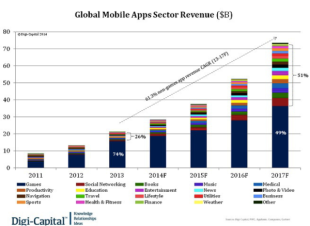 The Overview of Mobile Apps Market: Why You Should Enter Now
The Overview of Mobile Apps Market: Why You Should Enter Now
Above: Digi-Capital tracks huge mobile apps growth. Image Credit: Digi-Capital
The estimated number of mobile app developers is 2.3 million, which means that one developer out of eight is dealing with mobile apps. Apple, during its WorldWide Developer Conference, talked about 1.25 million apps in the App Store accounting for 50 billion downloads and $5 billion paid to developers last year. The average revenue for a developer is shown in the table below.
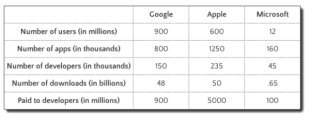 The Overview of Mobile Apps Market: Why You Should Enter Now
The Overview of Mobile Apps Market: Why You Should Enter Now
 The Overview of Mobile Apps Market: Why You Should Enter Now
The Overview of Mobile Apps Market: Why You Should Enter Now
Source: Forbes, How Much Do Average Apps Make?
It is expected that app downloads will grow to 200 billion while mobile app revenues in 2017 will be as huge as$63.5 billion. The transaction value for global mobile payments is projected to grow from $235 billion in 2013 to$721.3 billion in 2017.The main trigger behind rocketing mobile app usage is the growing sales of tablets, smartphones and other mobile devices.
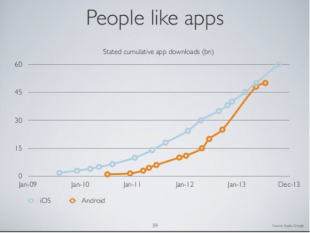 The Overview of Mobile Apps Market: Why You Should Enter Now
The Overview of Mobile Apps Market: Why You Should Enter Now
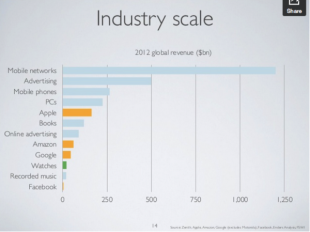 The Overview of Mobile Apps Market: Why You Should Enter Now
The Overview of Mobile Apps Market: Why You Should Enter Now
Source: Ben Evans, Mobile is Eating the World, 2013.
The growth is evident in all app categories. It is clear to mobile researchers that mobile apps are turning into huge distribution channels themselves, rather than staying as independent instruments of marketing communication. The reach, the frequency, and the retention rate are fascinating for mobile apps. It is significant that mobile app usage dominates the overall time spent on daily media consumption at 82%.
The majority of available apps are B2C since B2B mobile apps are only now starting to enter the mobile app market. The potential for growth is huge. Although the forecasts and the statistics from each research company are slightly different, you can still conclude that the app market is really big.
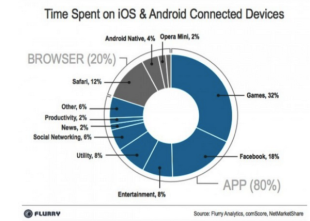 The Overview of Mobile Apps Market: Why You Should Enter Now
The Overview of Mobile Apps Market: Why You Should Enter Now
Who can you reach through mobile apps?
In the US, 67% of people use smartphones to access the Internet every day, and the majority won’t leave home without their phone. As the PewResearch Internet Project indicates, about half of all cell phone users have mobile apps installed, and two-thirds are regular mobile app users. Most users of mobile apps are between 25 and 30 years old, are married, live in suburban areas, and have had at least four years of college education. Mobile app users are generally younger, more educated and have higher income than other cell phone holders. Businesses that integrate mobile into their strategy can engage an entirely new type of customer – an instantly connected one. Smartphone users generally prefer to multi-task and be on-the-go.
Users who you can reach through mobile apps are more engaged and ready to communicate with your business as long as the channel of communication is accessible and they can find all the product info needed.
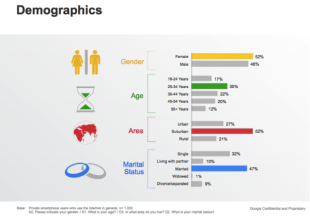 The Overview of Mobile Apps Market: Why You Should Enter Now
The Overview of Mobile Apps Market: Why You Should Enter Now
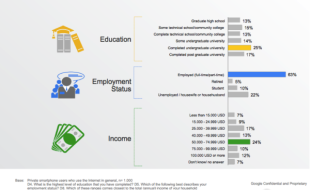 The Overview of Mobile Apps Market: Why You Should Enter Now
The Overview of Mobile Apps Market: Why You Should Enter Now
Mobile apps work to increase customer loyalty (especially in retail). Loyal customers tend to download free branded mobile apps more often and spend twice as much time on them than on a mobile website.
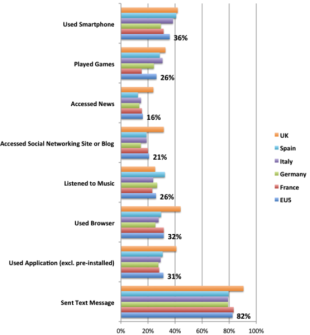 The Overview of Mobile Apps Market: Why You Should Enter Now
The Overview of Mobile Apps Market: Why You Should Enter Now
What are your development options for mobile apps?
Once you’ve decided to construct a mobile app, you ought to know who to turn to for assistance. The market players in mobile app development fall into six categories: management consultancies, mobile specialists, product development specialists, digital agencies, telcos, and systems integrators. According to Forrester Mobile Research, the market for mobile engagement providers will grow to $32.4 billion by 2018. The types of product that they offer are mostly app builders of varying designs and functionality. The services they provide belong to three categories: mobile engagement services, mobile app and device management, and mobile app development services.
- Mobile engagement services include demographic research, mobile strategy, user experience design, analytics, business process re-engineering, upgrades to back-end services and system consolidation.
- Mobile app and device management often comes with per-device fees.
- Mobile app development services include developing and maintaining native or hybrid apps for tablets and smartphones along with mobile websites and responsive design versions. Existing APIs are used to connect to back-end systems. These services do not include user experience design.
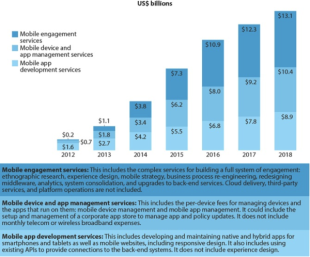 The Overview of Mobile Apps Market: Why You Should Enter Now
The Overview of Mobile Apps Market: Why You Should Enter Now
Source: Forbes, Mobile Engagement Providers Will Be A New $32.4 Billion Market By 2018.
Launching an app can be difficult for medium and small businesses but the main problem is maintenance. According to research from Distimo, only 2% to 3% of the top publishers in Apple’s App Store and the Android Google Play store are newcomers, which indicates the toughness of the challenge to build something exquisite and useful for users. The trick is that building an app and including all the necessary elements into it is only a small part of the job, as you also need to think about registering a developer’s account at Apple’s App Store or Google’s Play Market, submitting the app, hosting it, regular notifications, engagement, maintenance, minor bug fixes, adapting it to new operating systems, etc.
A survey among 100 iOS, Android and HTML5 developers demonstrates that the average time for building version one of a native mobile app takes 18 weeks. The work includes back-end tasks (data storage, user management, server-side logic, data integration, push, and versioning) and front-end tasks (caching, synchronization, wireframing, UI design, UI development and UI polish).
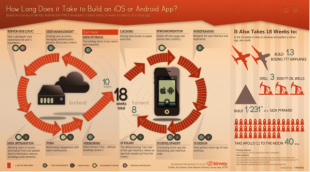 The Overview of Mobile Apps Market: Why You Should Enter Now
The Overview of Mobile Apps Market: Why You Should Enter Now
Source: visual.ly, How Long Does it Take to Build an iOS or Android App?
When small and medium businesses, freelancers and bloggers decide to build a native mobile app, they will most likely find app building services on Google offering a bunch of functions. Subscription plans vary from $10 to $1000 and no coding skills are required. Meanwhile, custom apps requiring months of development cost from $100,000 up to $2 million depending on the complexity of the app. The pricing strategy is quite complicated because, for instance, the relative cheapness of DIY services is driven by poor design, low technical quality, and maintenance issues with content updates, version updates, etc., which can cost a lot.
We saw a market niche for ourselves between custom development (with its huge budgets and time frames) and simple inconspicuous online builders. This is how our motto “Ready Mobile Apps” was born – you don’t need to mess about with settings and you can just enjoy beautifully framed content. Moreover, you can distribute the content using your brand without spending a good deal of money on designers and developers.
Huge corporations can afford to generate their own native apps with zillions of integrated elements, making the customer experience as flawless as possible. In the meantime, for small and medium businesses, and even freelancers connecting to a customer through content, a branded native mobile app might be a better choice.
Let us know what you think in the comments below.
This article was syndicated from Business 2 Community: The Overview of Mobile Apps Market: Why You Should Enter Now
More Tech articles from Business 2 Community:




